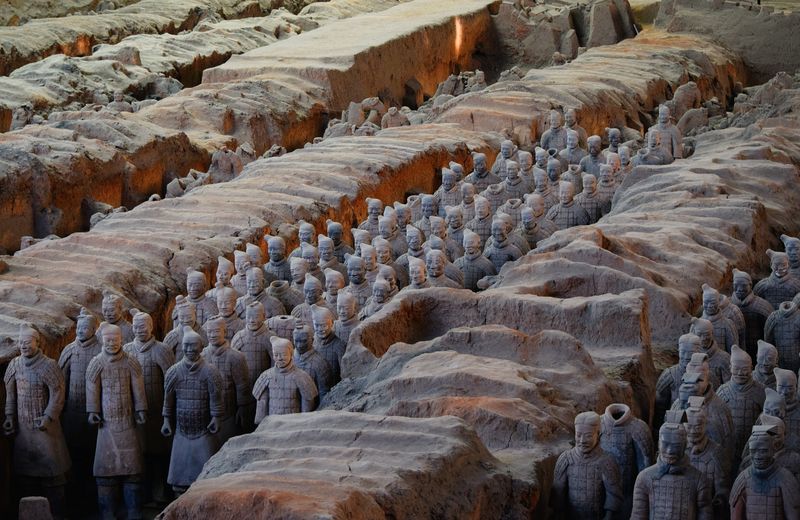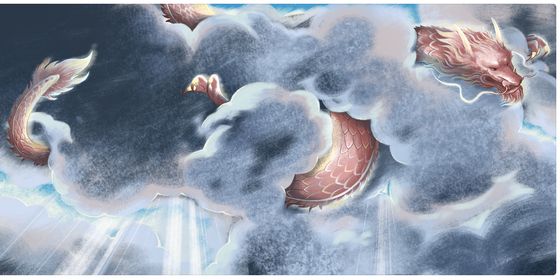Rivers of mercury, pearl-studded ceilings—the contents of the unopened burial chamber of Qin Shi Huang continue to baffle archaeologists
As many as 700,000 men dug deep to construct a vast underground city, a palace filled with priceless treasure at the center. Inside, they built a burial chamber with a soaring ceiling resembling the night sky and a floor modeled after the landmarks of the empire, complete with rivers of flowing mercury. Crossbows were planted to fire at unsuspecting grave robbers. Once completed, hundreds of concubines and craftsmen were sealed inside the towering mound of earth to make sure they took the secrets of what lay inside to the grave.
What reads like a passage from an adventure novel is actually a description of the burial of China’s first emperor, Qin Shi Huang (秦始皇), written by historian Sima Qian (司马迁) about a century after the emperor’s death in 210 BCE. Qin Shi Huang, known for uniting the seven Chinese feudal kingdoms at the time into one empire, ascended the throne of the Qin kingdom in 246 BCE at the age of 13. But it is his tomb, rather than his rule, that has proved most perplexing to archaeologists since. No one has been inside the burial chamber since its rediscovery in the 1970s; what lies within remains one of Chinese history’s most tantalizing mysteries.
Construction of Qin Shi Huang’s giant mausoleum began shortly after he took the throne and established the Qin dynasty (221 – 206 BCE). According to Sima Qian, hundreds of thousands of men conscripted from all over the empire worked together to finish the massive underground burial complex. The emperor was laid to rest there after his death at the age of 39.
Although Sima Qian’s account has been known for centuries, the exact location of the tomb was unknown until 1974. In a particularly dry March that year, Yang Zhifa and a group of fellow farmers from Lintong county in Shaanxi province ventured out into the scrubby plains at the foot of Mount Li, 35 kilometers east of the provincial capital Xi’an. Their mission was to dig a well for their cooperative farm, but the men found something much more valuable instead: at a depth of around three meters, they first struck hardened red earth, then terracotta fragments, then pieces of bronze ware. The farmers didn’t think much of it at the time, but took their findings to the local museum anyway—the rest is history.
They had found the now world-famous terracotta army. The numbers are staggering: Of the estimated 8,000 terracotta warriors, chariots, and horses buried with the emperor, battle-ready to protect him in the afterlife, only about a quarter have been unearthed so far. The largest pit, No. 1, is roughly the size of two soccer fields; one can only begin to imagine what the endless rows of intricately crafted, life-sized terracotta soldiers, archers, horses, and chariots must have looked like in their original paintwork, which mostly disintegrated due to exposure to the elements and early excavation errors. Several smaller pits have been found as well: some with civilian terracotta figures such as musicians and acrobats, others with precious metal artifacts including two imperial bronze chariots and 46 bronze birds.
If the surrounding area is filled with such treasures, what could be hidden inside the actual underground palace? That remains a mystery, because almost 50 years after the discovery, after droves of archaeologists have worked on the site and millions of tourists have visited it, the actual burial chamber remains sealed, with the emperor sleeping undisturbed under his 50-meter-tall mound of earth…or is he?
Since nobody has looked inside, some wonder whether the burial chamber could have been looted in the past. According to Sima Qian, Xiang Yu (项羽), a rebel leader who helped overthrow the Qin dynasty in 206 BCE, burned and looted the tomb around the time the Qin empire fell. There seem to be signs of fire damage in some areas of the complex, but experts like Wu Yongqi, former director of the Museum of Qin Terracotta Warriors and Horses, believe the actual burial chamber to be undisturbed.
Perhaps it is the mercury reportedly filling the burial chamber that has kept grave robbers away. Mercury is a potentially lethal neurotoxin, especially when it evaporates and is inhaled. Considering the vast amounts that would have been needed to simulate flowing rivers and seas inside the burial chamber as described by Sima Qian, it is conceivable that the tomb was a highly toxic environment, especially without modern protective gear. Some recent soil analysis in the area suggests unusually high mercury levels under the burial mound.
At the time of discovery, some local residents warned that disturbing the relics might bring a curse upon their village. Curiously, though the group of farmers that discovered the burial complex in 1974 never came anywhere near the mercury-laden burial chamber, two of them later died from undiagnosed illnesses in their 50s, one “of a skin disease that caused his body to rot away,” the other one “in great pain at his home,” a surviving discoverer told the South China Morning Post in 2007. “We have no idea what killed them.” Another discoverer committed suicide at the age of 60.
What ended up haunting the villagers most was no curse of the mummy, but rather the curse of greedy officials demolishing the village to make way for tourist attractions. “The government has taken away our land and our livelihoods and left us with nothing,” one resident told the South China Morning Post.
Some of those officials have argued in favor of unsealing the tomb for its touristic value, but no matter how great the economic potential, the actual burial chamber will most likely remain closed for the foreseeable future. “Letting Qin Shi Huang rest in peace for all eternity; that would be ideal,” said former museum director Yuan Zhongyi in an interview with Outlook Weekly in 2009.
But it is not just respect for the dead that keeps experts from unsealing the tomb. Yuan also pointed out that the burial mound itself, with its layers upon layers of rammed earth built to create a tight seal, is a cultural relic worthy of protection, especially considering that the necessary technology to preserve its contents may not be available yet. Instead, it may be better to leave the task to future generations with access to more advanced, non-invasive means of exploration: “Perhaps one day it won’t even be necessary to unearth the tomb at all,” Yuan suggested.













